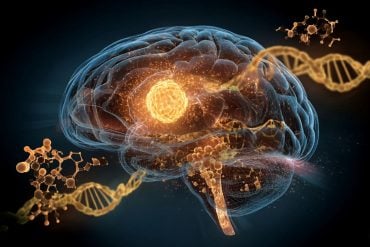Summary: Researchers have identified a potential new treatment method for Fragile X Syndrome (FXS), a leading cause of autism spectrum disorders. The method involves contracting the CGG trinucleotide repeat in the FMR1 gene, thereby restoring the essential FMRP protein expression necessary for brain development.
The researchers utilized inhibitors of two kinases (MEK and BRAF) to trigger the body’s DNA repair mechanisms, effectively reducing the expanded CGG repeats. The results mark a significant stride towards a potential “one-and-done” treatment for FXS.
Key Facts:
- FXS, which affects 1 in 3,000 boys and 1 in 6,000 girls, is caused by an expansion of the trinucleotide repeat CGG within the FMR1 gene.
- The new method discovered contracts this CGG repeat, stimulating the body’s own DNA repair mechanisms, and restores FMRP protein expression.
- The process required the presence of inhibitors of two kinases, MEK and BRAF, to induce repeat contraction and full FMR1 reactivation.
Source: Mass General
New research has identified a potential method for treating fragile X syndrome, a leading cause of autism spectrum disorders that is characterized by an inherited repeat of certain nucleotides within the DNA sequence of the FMR1 gene.
The work, which was conducted by investigators at Massachusetts General Hospital (MGH), is published in the journal Cell.
FXS is caused by an expansion of the trinucleotide repeat CGG within FMR1, which stands for Fragile X Messenger Ribonucleoprotein 1. FMR1 makes a protein called FMRP that is needed for brain development, but the CGG expansion in people born with FXS leads to reduced expression of this protein, leading to developmental delays, learning disabilities, and social and behavior problems.
The disorder affects 1 in 3,000 boys and 1 in 6,000 girls.
“We wondered if we could treat FXS by contracting the trinucleotide repeat in FMR1 and restoring FMRP expression,” explains senior author Jeannie T. Lee, MD, Ph.D., a molecular biologist at MGH and a professor of Genetics at Harvard Medical School.
“While the industry is trying to restore expression by gene therapy and gene editing, our approach was to contract the CGG repeat and restore protein expression by stimulating the body’s own DNA repair mechanisms.”
By generating models derived from the cells of patients with FXS and exposing the models to different laboratory conditions, Lee and postdoctoral fellow and first author, Hun-Goo Lee, Ph.D., discovered conditions that induce a strong repeat contraction and full FMR1 reactivation. The conditions required the presence of inhibitors of two kinases called MEK and BRAF.
Inhibiting these enzymes led to enhanced production of special nucleic acid structures called “R-loops” formed between DNA and RNA, which cells see as DNA damage and therefore trigger repair mechanisms to fix the problem.
The cells’ repair mechanisms then excise the expanded CGG repeats to achieve more normal CGG levels, enabling cells to re-express the crucial FMR1 gene.
“Because the disease is caused by the expanded CGG repeat, contracting the repeat through R-loop formation is potentially a one-and-done treatment,” says Lee. “We are now extending the technology to patient neurons and to the brain in animal models.”
Additional co-authors include Sachiko Imaichi, Elizabeth Kraeutler, Rodrigo Aguilar, Yong-Woo Lee, and Steven D. Sheridan.
About this autism research news
Author: Press Office
Source: Mass General
Contact: Press Office – Mass General
Image: The image is credited to Neuroscience News
Original Research: Closed access.
“Site-specific R-loops induce CGG repeat contraction and fragile X gene reactivation” by Hun-Goo Lee et al. Cell
Abstract
Site-specific R-loops induce CGG repeat contraction and fragile X gene reactivation
Highlights
- We identify an approach to excise long CGG repeats in fragile X syndrome
- CGG contraction involves recruitment of endogenous DNA repair machinery
- Site-specific R-loop formation is necessary and sufficient for the repeat contraction
- CGG repeat contraction reactivates the silenced FMR1 gene and restores FMRP protein
Summary
Here, we describe an approach to correct the genetic defect in fragile X syndrome (FXS) via recruitment of endogenous repair mechanisms. A leading cause of autism spectrum disorders, FXS results from epigenetic silencing of FMR1 due to a congenital trinucleotide (CGG) repeat expansion.
By investigating conditions favorable to FMR1 reactivation, we find MEK and BRAF inhibitors that induce a strong repeat contraction and full FMR1 reactivation in cellular models.
We trace the mechanism to DNA demethylation and site-specific R-loops, which are necessary and sufficient for repeat contraction. A positive feedback cycle comprising demethylation, de novo FMR1 transcription, and R-loop formation results in the recruitment of endogenous DNA repair mechanisms that then drive excision of the long CGG repeat.
Repeat contraction is specific to FMR1 and restores the production of FMRP protein. Our study therefore identifies a potential method of treating FXS in the future.








